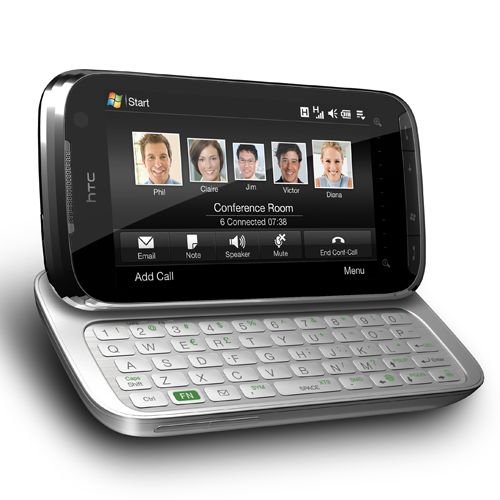HTC is more known of late for their phones running the Google mobile OS. What might be slipping from the public’s memory is their history of handsets running Windows Mobile. This latest handset is another one of their sequels, with the HTC Touch Diamond2 being the first of them to hit the shelves after being announced at Mobile World Congress in Barcelona early this year.
What's initially very noticeable about the HTC Touch Pro2 is that it doesn't resemble the HTC Touch Diamond or Diamond2 in any way. That might appear to be a little bit of an odd statement by itself, but it makes sense if you're familiar with those other handsets.
The handset the Touch Pro2 is succeeding, the HTC Touch Pro, was more or less the Touch Diamond only with a full QWERTY keyboard built-in. The original phone looked just like the very first Diamond, if viewed head on with the only difference being its thickness, due to the vertical slide out keyboard.
HTC has now made a full departure from the status quo and has created a new design this time around, which has a more curved rounded feel to its edges and casing. The Pro2 still carries some of the traits of the past model, as it can be operated as a touchscreen device or in conjunction with the QWERTY keyboard.
HTC has increased the screen size from the 2.8-inch TFT LCD display in the Touch Pro, to a 3.6-inch, 480 x 800-pixel resolution, touchscreen. This is very responsive with the handset being very accurate in dealing with the touch screen processing, much more so than in the last generation of these phones.
As a result you have a device that measures 116 x 59.2 x 16.65mm,
and weighs in at a hefty 178.5g.
Another noticeable change is the method of zooming in and out of the likes of web pages. Along the base of the screen is a zoom bar, where a slide of a finger over this area outside of the main screen scales the pages up and down in size. This is all very handy and a useful addition, where in the Pro this was inside of the screen and often the web page was accidently pressed by mistake which jumps to a link on the page.
HTC has worked on the mobile’s User Interface, besides just the aesthetic changes to the chassis of the Touch Pro2. The UI on top of Windows 6.1 - TouchFLO 3D - has been much more interwoven into the operating system. Beforehand, after a few accidental clicks you were straight back into Windows 6.1 whereas now the UI feels as though it is the OS, with much better handling of things like contacts.
One of the key aspects HTC is touting that's made its way to the Pro2 is their Push internet technology. This is all surrounding its Opera web browser where sections of websites can be bookmarked, these parts of the sites can then be viewed completely offline and automatically updated at a pre-set time. This can be seen like an extension to the RSS feeds, with the whole content now being viewable rather than just a headline and the first paragraph that makes a lot more sense for the consummate mobile web user.
HTC is really marketing this handset as a business tool, which is seen in the likes of the Straight Talk functionality. On the rear of the phone there is a large speaker and microphone built into the case, used for conferencing calling with the mobile, just like you would in a boardroom, and has the same quality too.
Highlighting how useful the Touch Pro2 could be as a business tool is the slide-out keyboard. It was so comfortable to type with we ended up writing this entire review on the phone. Although with the keyboard open and in-use the only way of holding the phone ended up powering off the device every now and then, as its holding point rests upon the power button.
One of our beefs with the HTC Touch Pro was battery life, which didn’t really power the phone through an average day. This time around they’ve added more of a capable battery, which in our tests makes it to just under 9 hours before dying.
Of course you get all the connectivity you expect here, with HSDPA pumping in high-speed data, Wi-Fi, Bluetooth and GPS are also present. There is no 3.5mm jack for your headphones, instead relying on the Mini-USB connection on the bottom. There is also a microSD card slot present to allow expansion of the memory.
Our quick take
HTC has made some great improvements to the original HTC Touch Pro, most of all not just cloning the Diamond2 and adding a keyboard. It’s a good business angled handset for the company, with a more sleek professional edge to its look and feel.
The UI has improved, along with its overall features and the keyboard is most of all great to use at length. There are some points where it was lacking, with a camera that should really be at 5 megapixel by now and the power button is unfortunately placed.

HTC Touch Pro2 - 4.5 / 5
| FOR | AGAINST |
|---|---|
|
|
To recap
A good second generation model or successor to the original HTC Touch Pro, with decent improvements from the first with only some minor flaws
